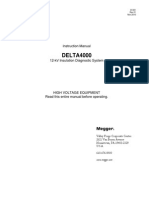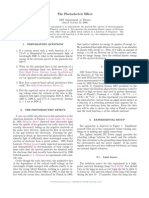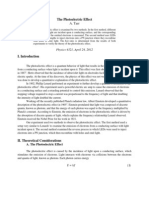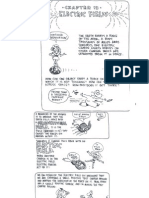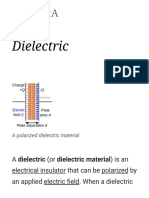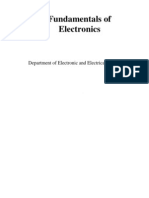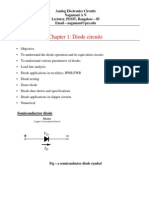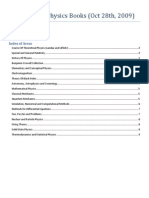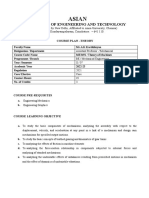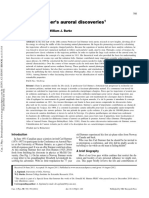Photoelectric Effect Notes
Photoelectric Effect Notes
Uploaded by
saifi_786Copyright:
Available Formats
Photoelectric Effect Notes
Photoelectric Effect Notes
Uploaded by
saifi_786Original Description:
Original Title
Copyright
Available Formats
Share this document
Did you find this document useful?
Is this content inappropriate?
Copyright:
Available Formats
Photoelectric Effect Notes
Photoelectric Effect Notes
Uploaded by
saifi_786Copyright:
Available Formats
Experiments verifying Quantum Theory of Radiation
Photoelectric Effect
Statement
Emission of electrons from the metal surface due to exposure of light of suitable
frequency, is known as photoelectric effect. The emitted electrons named as photoelectrons.
Experiment
Circuit diagram of an apparatus for studying the photoelectric effect is shown in
figure. An evacuated glass tube contains a metallic plate E (the emitter) connected to the
negative terminal of a battery and another metallic plate C (the collector) that is connected
to the positive terminal of the battery.
When the tube is kept in the dark, the galvanometer
reads zero, indicating no current in the circuit.
However, when plate E is illuminated by light
having an appropriate wavelength
(or suitable frequency), a current is detected
by the ammeter, indicating a flow of charges
across the gap between plates E and C.
This current arises from photoelectrons emitted
from plate E and collected at plate C.
Figure-2 is a plot of photoelectric current
versus potential difference 𝚫𝑽 applied between plates E
and C for two light intensities. At large values of 𝚫𝑽,
the current reaches a maximum value; all the electrons
emitted from E are collected at C, and the current cannot
increase further. In addition, the maximum current increases
as the intensity of the incident light increases, as you might
expect, because more electrons are ejected by the
higher-intensity light.
Now, if the battery in the circuit is reversed to make plate E positive and plate C
negative—the current drops because many of the photoelectrons emitted from E are
repelled by the now negative plate C. In this situation, only those photoelectrons having a
kinetic energy greater than 𝒆𝚫𝑽 reach plate C, where 𝒆 is the magnitude of the charge on
the electron. And at a certain value of 𝚫𝑽, called Stopping Potential, no electron has
enough energy (maximum kinetic energy) to encounter 𝒆𝑽, so current at the collector plate
becomes zero indicated by the ammeter. At this stage, 𝑲. 𝑬 = 𝒆𝑽 ⇒ 𝑲. 𝑬 − 𝒆𝑽 = 𝟎.
Predictions on the basis of classical theory (wave theory of light)
1. Dependence of K.E on intensity (intensity problem)
Electrons should absorb energy continuously from the electromagnetic waves. As the
light intensity incident on a metal is increased, energy should be transferred into the
metal at a higher rate and the electrons should be ejected with more kinetic energy.
2. Time interval between incidence light and emission of electrons (time delay problem)
At low light intensities, ejection of electron should take some time from the surface.
This time interval is required for the electron to absorb the incident radiation before it
acquires enough energy to escape from the metal.
3. Dependence of photoelectrons on frequency (frequency problem)
Electrons should be ejected from the metal at any incident light frequency, because
energy is transferred to the metal regardless of the incident light frequency.
4. Dependence of K.E on frequency (K.E of photoelectrons problem)
There should be no relationship between the frequency of the light and the electron
kinetic energy. The kinetic energy should be related to the intensity of the light.
Experimental evidences
1. The maximum kinetic energy of photoelectrons is independent of light intensity (as
shown) with both curves falling to zero at the same negative voltage. The maximum
kinetic energy is proportional to the stopping potential.
2. Electrons are emitted from the surface of the metal almost instantaneously even at very
low light intensities.
3. No electrons are emitted if the incident light frequency falls below some cutoff
frequency 𝒇𝒐 regardless of the light intensity.
4. The maximum kinetic energy of the photoelectrons increases with increasing light
frequency.
All experimental results contradicts the four prediction. So the classical theory does not
hold good in explaining the above phenomena. In 1905, Einstein made a successful
explanation on the basis of quantum theory. And he was awarded Noble Prize in 1921.
Einstein assumed light as steam of quanta carrying energy 𝑬 = 𝒉𝝂 (𝝂 read as nu), having
frequency 𝝂 moves with speed of light in vacuum.
Einstein’s Explanation
1. 𝑲. 𝑬𝒎 + 𝝓 = 𝒉𝝂 shows that 𝑲. 𝑬𝒎𝒂𝒙 is independent of the light intensity. The
maximum kinetic energy of any one electron depends only on the light frequency
and the work function. If the light intensity is doubled, the number of photons
arriving per unit time is doubled, which doubles the rate at which photoelectrons are
emitted. However 𝑲. 𝑬𝒎𝒂𝒙 remains unchanged.
2. Incident energy appears in small packets, and there is a one-to-one interaction
between photons and electrons. If the incident light has very low intensity, there are
very few photons arriving per unit time interval; each photon, however, can have
sufficient energy to eject an electron immediately. (no time delay)
3. The incident photons must have energy greater than or equal to the work function 𝝓
to eject an electron, the photoelectric effect cannot be observed below a certain
cutoff frequency. None of the photoelectrons will be observed, even though many
photons per unit time are incident on the metal in a very intense light beam,
4. A photon of higher frequency carries more energy and therefore ejects a
photoelectron with more kinetic energy than does a photon of lower frequency.
You might also like
- Physics Activity 4Document4 pagesPhysics Activity 4Ankit PanigrahiNo ratings yet
- Experiment No4Document4 pagesExperiment No4Mohsen SaidiNo ratings yet
- Electrical Properties of SolidsDocument4 pagesElectrical Properties of Solidsstephen james100% (1)
- Mam Ky02sDocument34 pagesMam Ky02sTaufan Justvands50% (4)
- MEGGER DELTA4310 Series 12kV Insulation Diagnostic System User ManualDocument108 pagesMEGGER DELTA4310 Series 12kV Insulation Diagnostic System User ManualcataconstantinNo ratings yet
- Photoelectric EffectDocument16 pagesPhotoelectric EffectRushita LingiahNo ratings yet
- Einstein Photoelectric EffectDocument18 pagesEinstein Photoelectric EffectSukhwinder Singh GillNo ratings yet
- Photoelectric Effect PDFDocument7 pagesPhotoelectric Effect PDFVenu GopalNo ratings yet
- Chapter 11 Nuclear StructureDocument38 pagesChapter 11 Nuclear StructureAimi NabilaNo ratings yet
- Practical TransformerDocument9 pagesPractical TransformerCJP TVNo ratings yet
- Electric Field Phs122Document52 pagesElectric Field Phs122Danika LoavesNo ratings yet
- (MIT) The Photoelectric EffectDocument4 pages(MIT) The Photoelectric EffectTVFionnaXQNo ratings yet
- Transformer Basics and Principles of OperationDocument6 pagesTransformer Basics and Principles of Operationmkeen85No ratings yet
- Physical Electronics PRACTICE QUESTIONS SheetDocument3 pagesPhysical Electronics PRACTICE QUESTIONS SheetHosea MuchiriNo ratings yet
- RQS 6 - Transmission Lines - AnswersDocument6 pagesRQS 6 - Transmission Lines - AnswersRenz Benhar Ocon BobadillaNo ratings yet
- Photoelectric EffectDocument6 pagesPhotoelectric Effectabc abc100% (1)
- PH6251-Engineering Physics II-with AnswersDocument58 pagesPH6251-Engineering Physics II-with Answersjj012586100% (2)
- Thermionic EmissionDocument22 pagesThermionic EmissionHazel LawNo ratings yet
- The Photoelectric EffectDocument11 pagesThe Photoelectric EffectAlex Tarr100% (1)
- AdvPhElec PheT ANSWSDocument11 pagesAdvPhElec PheT ANSWSnatehochNo ratings yet
- Electric FieldDocument42 pagesElectric FieldMuhammad Kashif IshaqueNo ratings yet
- Electric Charges and FieldsDocument21 pagesElectric Charges and Fieldsadvaith0% (1)
- Problem and Solution Electric FieldDocument10 pagesProblem and Solution Electric FieldSansen Diamante Colipano Jr.No ratings yet
- AC and DC CircuitsDocument3 pagesAC and DC CircuitsEugene Embalzado Jr.No ratings yet
- 01 Properties of Electric Charges PDFDocument28 pages01 Properties of Electric Charges PDFSeroKeretaMasaroWidiarNo ratings yet
- Emission and Absorption SpectraDocument2 pagesEmission and Absorption SpectraHossainNo ratings yet
- Energy Bands in SolidsDocument4 pagesEnergy Bands in SolidsTHIRU VAZAHANNo ratings yet
- Topic 12.1 - The Interaction of Matter With Radiation - AHLDocument79 pagesTopic 12.1 - The Interaction of Matter With Radiation - AHLPaul Amezquita100% (1)
- Electricity - Lesson 8 - EMF and Internal ResistanceDocument18 pagesElectricity - Lesson 8 - EMF and Internal ResistanceJeemion JealiNo ratings yet
- DielectricDocument53 pagesDielectricPraveen KumarNo ratings yet
- Chapter 5Document38 pagesChapter 5Jayaprakash Reddy100% (1)
- Lab Report #1 Photoelectric EffectDocument8 pagesLab Report #1 Photoelectric EffectJohn FiveNo ratings yet
- Capacitor Lab ReportDocument10 pagesCapacitor Lab ReportKarla MaalihanNo ratings yet
- 11 True/False Questions: Name: ScoreDocument6 pages11 True/False Questions: Name: ScoreAtharv GandhiNo ratings yet
- Electric CurrentDocument9 pagesElectric CurrentmerryNo ratings yet
- Magnetic Materials: 3.1 IntroductionDocument49 pagesMagnetic Materials: 3.1 IntroductionCurious ManNo ratings yet
- Electric Field and PotentialDocument27 pagesElectric Field and Potentialthinkiit50% (2)
- Electric Flux and Gauss's Law PDFDocument19 pagesElectric Flux and Gauss's Law PDFsNo ratings yet
- Diode ConstructionDocument3 pagesDiode ConstructionJelita Shaleha SibaraniNo ratings yet
- Lecture 4 - Current Density, Conductors and CapacitanceDocument34 pagesLecture 4 - Current Density, Conductors and CapacitanceHannahmhel MuanaNo ratings yet
- Chapter 2 Carrier Transport PhenomenaDocument56 pagesChapter 2 Carrier Transport PhenomenaMamapaiya HaariNo ratings yet
- OptoelectronicsDocument23 pagesOptoelectronicsChristian Dave TamparongNo ratings yet
- Physics Report Band Gap of SemiconductorDocument5 pagesPhysics Report Band Gap of SemiconductorTumzangwanaNo ratings yet
- Fundamental of ElectronicsDocument18 pagesFundamental of ElectronicsJaime R. Fulguerinas100% (1)
- Unit 1 Lect-1 PDFDocument21 pagesUnit 1 Lect-1 PDFECE A SRM VDP100% (2)
- Unit1 Diode CircuitsDocument41 pagesUnit1 Diode CircuitsJagan GNNo ratings yet
- Applied Physics-Department of CS-UOGDocument2 pagesApplied Physics-Department of CS-UOGRukaiya Akram50% (2)
- Unit-1 Semiconductor Diodes PDFDocument103 pagesUnit-1 Semiconductor Diodes PDFRajarao MandaNo ratings yet
- Kasap SM Ch01 - Solution Manual For Chapter 1 Kasap SM Ch01 - Solution Manual For Chapter 1Document72 pagesKasap SM Ch01 - Solution Manual For Chapter 1 Kasap SM Ch01 - Solution Manual For Chapter 1MUCKRAKERNo ratings yet
- Electronics Tutorials WsDocument11 pagesElectronics Tutorials WsDev BuddyNo ratings yet
- EEE2212 PHYSICAL ELECTRONICS II Chapter 1 PDFDocument23 pagesEEE2212 PHYSICAL ELECTRONICS II Chapter 1 PDFPaul KabiruNo ratings yet
- 000 - MSC Physics-Curriculum 21.06.2016Document47 pages000 - MSC Physics-Curriculum 21.06.2016Vijay SinghNo ratings yet
- EE 413-Engg ElectromagneticsDocument2 pagesEE 413-Engg ElectromagneticsVan GonzalesNo ratings yet
- The InductorDocument25 pagesThe InductorSureshraja9977No ratings yet
- General Physics Lab Report: Faculty of Engineering and TechnologyDocument19 pagesGeneral Physics Lab Report: Faculty of Engineering and TechnologyIzaNo ratings yet
- 7 Magnetic Forces Materials InductanceDocument34 pages7 Magnetic Forces Materials InductanceVienNgocQuang100% (1)
- Photoelectric Effect Lecture NotesDocument33 pagesPhotoelectric Effect Lecture NotesSebastian Quiceno100% (1)
- Chapter 1 - Semiconductor DiodesDocument31 pagesChapter 1 - Semiconductor DiodesYus Nordin100% (1)
- Module 2Document171 pagesModule 2ddfjfjfds dlijkfdifNo ratings yet
- Dielectric Constant KitDocument12 pagesDielectric Constant KitNeha AgarwallaNo ratings yet
- Photo-Electric Effect and ComptonDocument7 pagesPhoto-Electric Effect and ComptonMohammad Irfan YousufNo ratings yet
- Topic 6 HandoutDocument12 pagesTopic 6 HandoutnattydreadfathelahNo ratings yet
- 3 - Assignment - PH 401 (EE) - MODULE - 3 (Magnetostatics)Document3 pages3 - Assignment - PH 401 (EE) - MODULE - 3 (Magnetostatics)saifi_786No ratings yet
- Ac 2008-90: Improving Students' Understanding of Magnetism: Chandralekha Singh, University of PittsburghDocument16 pagesAc 2008-90: Improving Students' Understanding of Magnetism: Chandralekha Singh, University of Pittsburghsaifi_786No ratings yet
- Objective Physics II-Year Class: (Full Book)Document2 pagesObjective Physics II-Year Class: (Full Book)saifi_786No ratings yet
- Superior Model School: Time: 1hr Subject: Mathematics Max Marks: Class: 6Document5 pagesSuperior Model School: Time: 1hr Subject: Mathematics Max Marks: Class: 6saifi_786No ratings yet
- Physics XII (Objective) Marks 200 Time 2hrsDocument6 pagesPhysics XII (Objective) Marks 200 Time 2hrssaifi_786No ratings yet
- Rays From Copper Is - What Is The EnergyDocument1 pageRays From Copper Is - What Is The Energysaifi_786No ratings yet
- Departmental Promotion SST To SS (Bio) - AppealDocument2 pagesDepartmental Promotion SST To SS (Bio) - Appealsaifi_786No ratings yet
- Objective Physics XI-Class: Max. Marks 150 Time Allowed: 1Document4 pagesObjective Physics XI-Class: Max. Marks 150 Time Allowed: 1saifi_786No ratings yet
- 200 Mcqs 1st YearDocument6 pages200 Mcqs 1st Yearsaifi_786No ratings yet
- Parallel Axes TheoremDocument4 pagesParallel Axes Theoremsaifi_786No ratings yet
- Paper Chemistry 1st Year (1st)Document1 pagePaper Chemistry 1st Year (1st)saifi_786No ratings yet
- Saif-Ur-Rehman: P R O F I L EDocument3 pagesSaif-Ur-Rehman: P R O F I L Esaifi_786No ratings yet
- Collection of Physics EbooksDocument9 pagesCollection of Physics EbooksDouglas Delgado de Souza53% (15)
- RLC Series Circuit SimplifiedDocument2 pagesRLC Series Circuit Simplifiedsaifi_786No ratings yet
- Simulation Lab Manual: NAME Rajveer Singh ROLL NO. BE/25085/16 Be (Eee) - ViiDocument12 pagesSimulation Lab Manual: NAME Rajveer Singh ROLL NO. BE/25085/16 Be (Eee) - ViiRajveerNo ratings yet
- Free OscillationsDocument8 pagesFree OscillationsAnonymous 70j56EwNo ratings yet
- Construction Operation and Basic Control of VR, PM and Hybrid Type Stepper MotorsDocument5 pagesConstruction Operation and Basic Control of VR, PM and Hybrid Type Stepper MotorsSew KariyawasamNo ratings yet
- PHY422820 LagrangianproblemsDocument90 pagesPHY422820 LagrangianproblemsLucero DelugoNo ratings yet
- Rated Operational Current: InstructionsDocument12 pagesRated Operational Current: InstructionsJhon SanabriaNo ratings yet
- Oscillations: Important PointsDocument24 pagesOscillations: Important PointsHari KrishnaNo ratings yet
- ME Week 9 WaveguidesDocument33 pagesME Week 9 WaveguidesSaad NadeemNo ratings yet
- Maintenance Handbook On Protection Fuses and Relays of Electric LocomotivesDocument54 pagesMaintenance Handbook On Protection Fuses and Relays of Electric LocomotivesSonu Singh Maurya100% (1)
- STD 12th Precise Physics 2 Notes Science MH BoardDocument21 pagesSTD 12th Precise Physics 2 Notes Science MH BoardAkhilesh SengarNo ratings yet
- UNIT-III-Free Electron TheoryDocument8 pagesUNIT-III-Free Electron TheoryGopichand surupulaNo ratings yet
- Electrical Panel Load Calculation (28!5!11)Document28 pagesElectrical Panel Load Calculation (28!5!11)Kushtrim MalaNo ratings yet
- Fundamentals of ESD Part 5 Device Sensitivity and TestingDocument8 pagesFundamentals of ESD Part 5 Device Sensitivity and TestingEdward FernandesNo ratings yet
- CE-101 Engineering MechanicsDocument4 pagesCE-101 Engineering MechanicsAbdul Rafey Nawaz100% (1)
- MCQ Microwave PDM 21122011Document3 pagesMCQ Microwave PDM 21122011Anonymous IXvuFdeNo ratings yet
- ErwinCoumans ExploringMLCPSolversAndFeatherstoneDocument85 pagesErwinCoumans ExploringMLCPSolversAndFeatherstoneThomas AtkinsNo ratings yet
- Lecture13 Chapter4 BoostandBuckBoost CCM Analysis-1Document22 pagesLecture13 Chapter4 BoostandBuckBoost CCM Analysis-1Buridi JahnaviNo ratings yet
- Lightning DesignDocument108 pagesLightning Designbakien-can100% (1)
- Omchi (Luo Clement) - The Ancient Science of NumbersDocument28 pagesOmchi (Luo Clement) - The Ancient Science of NumbersClaudeo RadityatamaNo ratings yet
- ME3491 Course PlanDocument9 pagesME3491 Course Planmanoj1316kumar_63152No ratings yet
- Over and Under Voltage Relay CharacteriticsDocument24 pagesOver and Under Voltage Relay CharacteriticsKashif RehmanNo ratings yet
- Gimbal Orientation Study and Assessment For The Autonomous Underwater Vehicles2020Document15 pagesGimbal Orientation Study and Assessment For The Autonomous Underwater Vehicles2020VipinBaislaNo ratings yet
- Analysis and Simulation of The High-Speed Torque Performance of BrushleDocument10 pagesAnalysis and Simulation of The High-Speed Torque Performance of BrushlePhạm Văn TưởngNo ratings yet
- Carl Størmer's Auroral Discoveries: Alv Egeland and William J. BurkeDocument9 pagesCarl Størmer's Auroral Discoveries: Alv Egeland and William J. BurkesantiagoNo ratings yet
- Fundamentals of Physics Sixth Edition: Halliday Resnick WalkerDocument5 pagesFundamentals of Physics Sixth Edition: Halliday Resnick WalkerPamela SotoNo ratings yet
- Jeetu College OptionsDocument1 pageJeetu College OptionsJithendra BhattiproluNo ratings yet
- Earthing Design Calculations R2Document6 pagesEarthing Design Calculations R2Chitra Satheesan100% (1)
- 1.1 Resultant Force 2021Document20 pages1.1 Resultant Force 2021SHASWIN RAJ A/L KARTTIKAN MoeNo ratings yet
- QI Module 2 Week 2Document3 pagesQI Module 2 Week 2Angel May Rodriguez100% (1)




